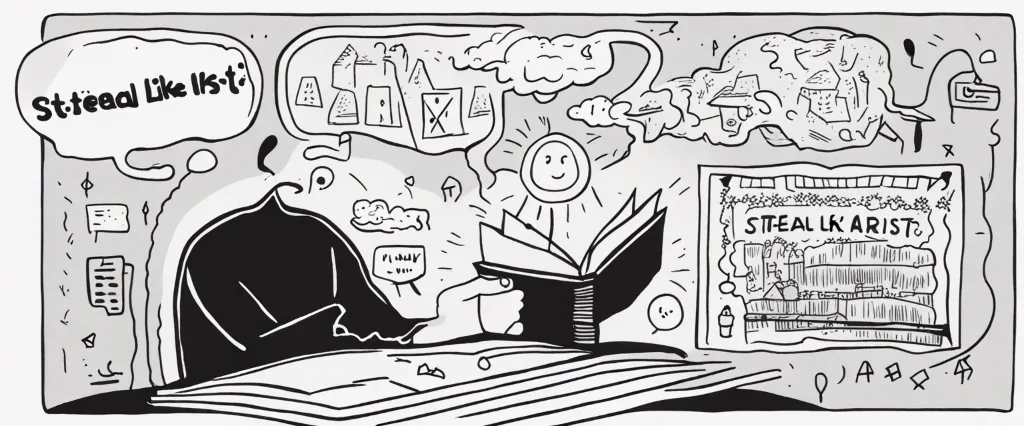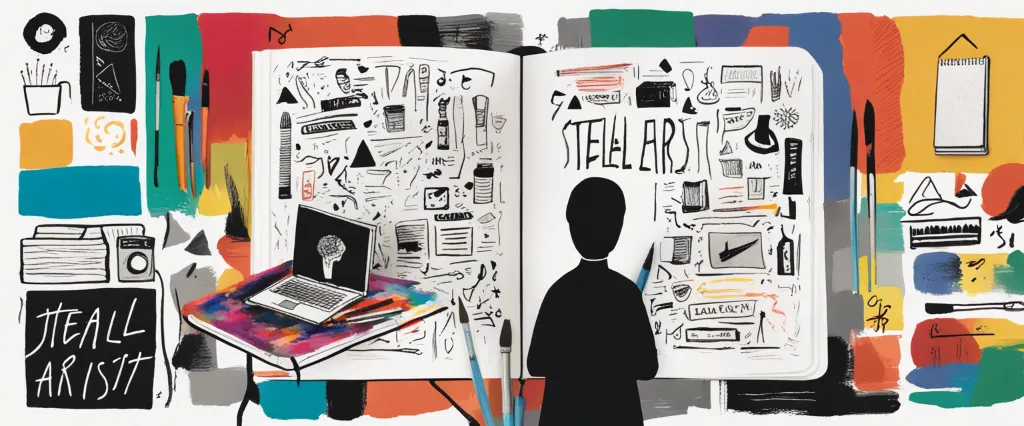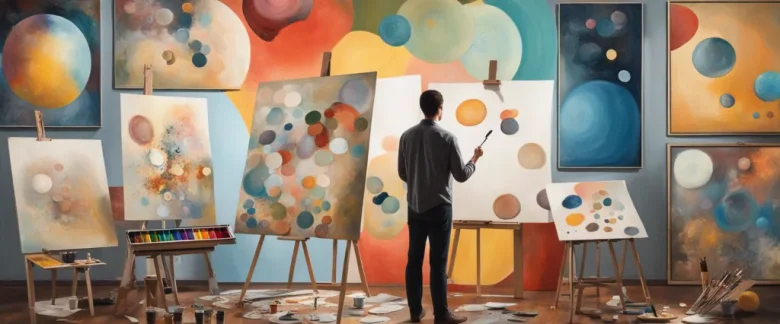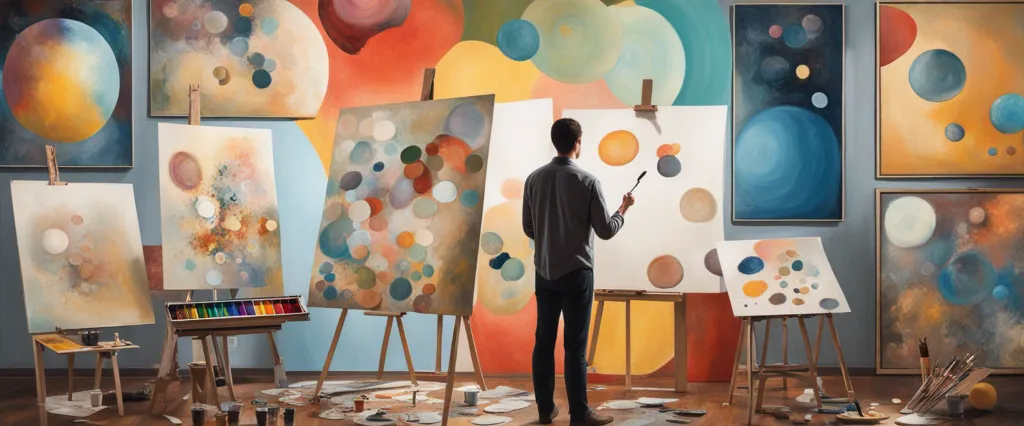In his immensely popular book, “Steal Like an Artist,” Austin Kleon presents a refreshing perspective on the creative process, urging readers to embrace the act of borrowing ideas and finding inspiration through various mediums. Kleon, a renowned writer, artist, and speaker, believes that all artists, whether they be writers, painters, musicians, or entrepreneurs, can benefit from the practice of “stealing” ideas. By drawing on a diverse range of influences, he argues, we can unlock our own unique creative potential and devise extraordinary works that connect with others on a profound level.
Chapter 1: You Are a Mashup of What You Let into Your Life
Chapter 1 of “Steal Like an Artist” by Austin Kleon is titled “You Are a Mashup of What You Let into Your Life.” The chapter focuses on the idea that creativity is not an original, isolated process, but rather a result of combining and remixing various influences from our surroundings.
Kleon begins by encouraging readers to embrace the fact that nothing is completely original and that all artists are influenced by the things they consume. He emphasizes the importance of being aware of what we allow into our lives, as it directly impacts our creativity. He stresses that making conscious choices about what to expose ourselves to can enhance our creative output.
The author presents his concept of the “creative family tree,” which he defines as the influences, inspirations, and interests that shape and guide an artist’s work. He advises readers to curate their creative family tree by seeking out diverse sources of inspiration such as books, music, films, art, and even people who inspire them. By doing so, he asserts that we can broaden our perspectives and contribute to our own unique artistic voice.
Kleon also emphasizes the importance of being selective in our consumption habits, avoiding mindless scrolling on social media or getting overwhelmed by excessive information. He suggests paying attention to the things that truly inspire us and striving to incorporate those influences into our artistic endeavors.
In summary, Chapter 1 of “Steal Like an Artist” encourages readers to embrace the reality that creativity is a result of combining, remixing, and being influenced by a variety of sources. Kleon urges readers to carefully curate their creative family tree by actively seeking out diverse and meaningful inspirations, and being mindful of the content they consume. By doing so, individuals can enhance their creative output and develop their own unique artistic voice.
Chapter 2: Don’t Wait Until You Know Who You Are to Get Started
In Chapter 2 of “Steal Like an Artist” by Austin Kleon, titled “Don’t Wait Until You Know Who You Are to Get Started,” the author encourages readers to embrace the creative process and start creating without worrying about having a clear, definitive identity.
Kleon emphasizes that waiting to know who you are before you begin creating may hinder your progress and lead to creative stagnation. He suggests that the act of creating helps individuals discover who they truly are, rather than waiting for a revelation to occur before starting. By engaging in creative activities, experimenting with different mediums, and pushing boundaries, one can gradually uncover their passions and artistic voice.
The author emphasizes the importance of learning from others and embracing influence. Kleon argues that everyone, consciously or unconsciously, is influenced by others’ work, and that this is not only natural but also crucial for growth and originality. By actively seeking out inspiration from various sources, such as artists, writers, musicians, and thinkers, one can expand their creative toolbox and find unique ways of expressing themselves.
Kleon also discusses the concept of remixing and urges readers to repurpose and reinterpret existing ideas and works to create their own vision. Through remixing, artists can add their personal touch and create something that is a reflection of their identity and experiences.
In summary, Chapter 2 of “Steal Like an Artist” encourages individuals to begin creating without feeling the need to have a fixed identity. By embracing influence, learning from others, and remixing existing ideas, artists can discover their true selves through the creative process and forge their own unique artistic path.
Chapter 3: Write the Book You Want to Read
Chapter 3 of “Steal Like an Artist” by Austin Kleon, titled “Write the Book You Want to Read,” explores the concept of creating the kind of art or material that resonates with you as an individual. Kleon emphasizes that your interests and passions play a crucial role in the kind of work you produce.
The chapter begins by addressing the importance of creating something you would enjoy experiencing yourself. Kleon advises writers to produce the book they would love to read, highlighting that this approach ensures authenticity and genuine passion in their work. He encourages individuals to embrace their unique interests, as this is what distinguishes their work from others’.
To create the book you want to read, Kleon urges artists to consider what they find missing in the world. By identifying the gaps or voids in the creative landscape, one can explore new possibilities and contribute something truly unique. He suggests combining different genres, styles, and influences to craft a new perspective and voice within the chosen medium.
Furthermore, the chapter emphasizes the role of personal taste in the creative process. Rather than fearing judgment, Kleon advises embracing one’s own tastes and curating them to inform their own work. By taking inspiration from a diverse range of sources and artists, a unique personal style can be developed, resonating with like-minded individuals who share similar interests.
In summary, Chapter 3 of “Steal Like an Artist” encourages individuals to create the kind of material they would enjoy consuming themselves. By embracing personal interests, identifying gaps in the creative landscape, and remaining true to one’s own tastes, artists can produce work that is authentic, unique, and appealing to others who share similar passions.
Chapter 4: Use Your Hands

Chapter 4: Use Your Hands of the book “Steal Like an Artist” by Austin Kleon encourages readers to embrace the use of their hands as a tool for creative expression and productivity. Kleon argues that in today’s digital age, many people have become disconnected from the physical world and are overly reliant on technology. He advocates for a return to using our hands as a way to deepen our creativity and engage with the world in a more meaningful way.
Kleon believes that engaging in hands-on activities, such as drawing, painting, writing by hand, or crafting, stimulates different parts of our brains and enhances our cognitive abilities. He encourages readers to explore various creative outlets and to experiment with different mediums. By using our hands, we can discover new ways of thinking and problem-solving that might not be accessible through digital means alone.
Another benefit of using our hands is the ability to create physical objects. Kleon emphasizes the value of making something tangible and having a physical presence in the world. This act of creation not only brings a sense of accomplishment but also allows for a deeper connection to our work and the audience who engages with it.
Additionally, Kleon touches on the idea of using our hands as a means of slowing down in a fast-paced world. Engaging with manual tasks requires focus, patience, and attention to detail, which can all contribute to a sense of mindfulness and present-moment awareness. By allowing ourselves to be fully present in our activities, we can find greater satisfaction and fulfilment in our creative pursuits.
In summary, Chapter 4 of “Steal Like an Artist” encourages readers to reconnect with the physical world by using their hands as tools for creativity. Whether it is through drawing, writing, crafting, or other manual activities, Kleon argues that by engaging with physical mediums, we can enhance our creativity, deepen our connection to our work, and find solace in the present moment.
Chapter 5: Side Projects and Hobbies Are Important
Chapter 5 of the book “Steal Like an Artist” by Austin Kleon is titled “Side Projects and Hobbies Are Important.” In this chapter, Kleon emphasizes the importance of pursuing side projects and engaging in hobbies as a way to foster creativity and personal growth.
Kleon begins by stating that side projects and hobbies can provide a creative outlet and allow individuals to explore different interests beyond their main work. They provide a space for experimentation, free from the constraints and pressures of traditional work. These projects allow individuals to develop new skills, learn from various sources, and stimulate their imagination.
The author suggests that side projects can serve as “stepping stones” to bigger and more ambitious endeavors. By dedicating time to these creative endeavors on the sidelines, individuals can gradually build the confidence and expertise needed to pursue larger goals. These side projects can also serve as a means of discovery, helping individuals explore new ideas and potential paths in their lives.
Kleon argues that hobbies are essential for maintaining a healthy work-life balance. Engaging in activities purely for enjoyment can increase overall happiness and prevent burnout. Furthermore, hobbies provide opportunities for relaxation and self-expression, which are crucial to maintaining mental well-being.
Throughout the chapter, Kleon shares examples of individuals who have successfully integrated side projects and hobbies into their lives, emphasizing that creativity is not limited to one particular field or job. He encourages readers to explore their interests, follow their curiosity, and embrace the joy of creating without the expectation of making a profit.
In summary, Chapter 5 of “Steal Like an Artist” highlights the significance of side projects and hobbies in nurturing creativity, personal development, and overall well-being. It encourages readers to make time for activities beyond their main work, to explore new passions, and to find enjoyment in the process of creation.
Chapter 6: The Secret: Do Good Work and Share It with People
Chapter 6 of “Steal Like an Artist” by Austin Kleon, titled “The Secret: Do Good Work and Share It with People,” emphasizes the importance of creating meaningful work and the significance of sharing it with others. Kleon argues that keeping your work hidden prevents it from making an impact or receiving feedback that can lead to growth and improvement.
The chapter commences with the idea that the more work you create, the better you become at it. Kleon encourages readers to produce a large volume of work, acknowledging that not everything will be exceptional, but the more you create, the higher the chance of producing something truly remarkable. He suggests cultivating a daily creative routine to maximize productivity.
Kleon emphasizes the importance of sharing your work, as it allows others to interact with and appreciate your creations. Sharing creates the potential for feedback, connecting with like-minded people, and building a community of supporters. He highlights the significance of embracing the digital age, which offers countless platforms for sharing work—blogs, social media, and online communities.
Additionally, the author advises being generous with sharing and collaborating with others. By giving credit, engaging in conversations, and participating in creative communities, individuals can foster a network that encourages inspiration and growth.
Kleon concludes the chapter by reminding readers that the ultimate goal is not fame or recognition but rather the satisfaction of creating meaningful work and sharing it with others. By focusing on doing good work and sharing it openly, individuals can build a strong creative identity and inspire others in the process.
Chapter 7: Geography Is No Longer Your Master
Chapter 7 of “Steal Like an Artist” by Austin Kleon, titled “Geography Is No Longer Your Master,” explores the idea that in the digital age, physical location is no longer a limitation for artists. Kleon argues that geography used to be a barrier, forcing individuals to rely on local resources and opportunities. However, with the vast possibilities offered by the internet, artists now have access to a global community and can connect with like-minded people regardless of their location.
The chapter begins by highlighting the story of Neil Gaiman, a well-known author who resides in rural Wisconsin. Gaiman’s success serves as an example of how the internet breakdowns the geographical barriers artists once faced. Through the use of online platforms, Gaiman has been able to reach a massive audience and collaborate with artists from all over the world. He demonstrates that physical proximity is no longer essential for creative collaboration.
Furthermore, the chapter emphasizes the importance of building an online presence as an artist. Kleon suggests that having a website or an active social media presence can help establish connections and showcase one’s work to a wider audience. Artists can create their own platforms to share their art and find a supportive community.
Kleon also encourages artists to seek out online communities and forums related to their interests. These virtual spaces allow artists to network, exchange ideas, and collaborate with other creatives from various backgrounds and parts of the world.
In conclusion, “Geography Is No Longer Your Master” emphasizes the immense potential and freedom offered by the internet. Artists can overcome geographical limitations, connect with a global audience, and find like-minded individuals to collaborate with, ultimately enriching their creative practice.

Chapter 8: Be Nice (The World Is a Small Town)
Chapter 8: Be Nice (The World Is a Small Town) of the book Steal Like an Artist by Austin Kleon emphasizes the importance of building positive relationships and treating others with kindness. Kleon begins by highlighting how the creative world is smaller than we realize, with networks and connections stretching far beyond our immediate circles. He suggests that being nice to others is not only the ethical way to behave, but it can also open doors and lead to valuable opportunities.
The chapter delves into four main aspects of being nice. First, Kleon addresses the idea of being genuinely interested in others and their work. By showing curiosity and taking the time to engage with people’s ideas and creations, we can establish meaningful connections. Next, he advises artists to always be generous, both with their knowledge and resources. Sharing tips, feedback, and resources not only helps others but can also foster a sense of community.
Kleon also highlights the significance of being authentic and honest in interactions. Instead of putting up a facade or trying to impress others, he encourages artists to be themselves, as authenticity builds trust and attracts like-minded individuals. Lastly, the chapter emphasizes the importance of remembering those who have offered assistance or support along the way. Kleon emphasizes the value of expressing gratitude and nurturing these relationships over time.
To summarize, Chapter 8 of Steal Like an Artist underscores the significance of being kind and considerate to others in the creative world. By showing genuine interest, being generous, authentic, and grateful, artists can cultivate experiences that enrich their creative journey and open unexpected doors for their work.
After Reading
In conclusion, “Steal Like an Artist” by Austin Kleon is a thought-provoking and inspiring book that challenges the traditional notions of creativity. Kleon encourages readers to embrace the concept of stealing ideas as a means of fueling their own creativity and originality. He emphasizes the importance of finding influence in diverse sources, being open to collaboration, and sharing your work with the world. With practical tips and engaging anecdotes, Kleon guides aspiring artists, writers, and creatives to unlock their full potential. By embracing the art of stealing like an artist, readers are empowered to redefine their own creativity and pursue a lifelong journey of artistic growth.
1. “Show Your Work!: 10 Ways to Share Your Creativity and Get Discovered” by Austin Kleon
If you enjoyed “Steal Like an Artist,” you’ll love Kleon’s “Show Your Work!” In this book, Kleon explores the importance of sharing your creative process with the world and shows strategies for becoming more visible and connected with an audience. With practical advice and inspiring examples, this book will help you understand how to navigate the digital age as a creative.
2. “Big Magic: Creative Living Beyond Fear” by Elizabeth Gilbert
Elizabeth Gilbert, the author of “Eat, Pray, Love,” shares her insights on living a life full of creativity in “Big Magic.” Drawing from personal experiences and anecdotes, Gilbert encourages readers to embrace curiosity, tackle creative fears, and commit to the pursuit of their passions. This book will inspire you to tap into your own creative potential.
3. “The War of Art: Break Through the Blocks & Win Your Inner Creative Battles” by Steven Pressfield
Steven Pressfield’s “The War of Art” offers practical advice for overcoming creative blocks and achieving creative success. Pressfield explores the concept of resistance, which keeps us from fulfilling our creative potential, and provides strategies to overcome it. This book provides a fresh perspective on creative struggles and will motivate you to overcome obstacles in your own creative journey.
4. “Steal Like an Artist Journal: A Notebook for Creative Kleptomaniacs” by Austin Kleon
For those who enjoyed the format and creativity exercises provided in “Steal Like an Artist,” this companion journal is a perfect recommendation. Filled with prompts, inspirational quotes, and space for recording ideas, this journal encourages active creativity and reflection. It’s a great tool to further explore your own creative process.
5. “Art & Fear: Observations on the Perils (and Rewards) of Artmaking” by David Bayles and Ted Orland
“Art & Fear” offers insights into the challenges faced by artists and creatives of all kinds. Bayles and Orland explore the fears and doubts that can hinder artistic growth and provide strategies for overcoming them. This book offers reassurance and guidance, reminding readers that creative struggles are universal and can be overcome with perseverance and dedication.




